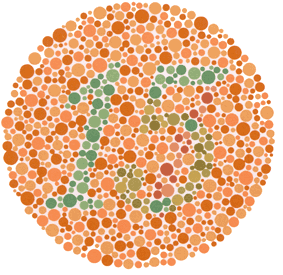Colour Blindness Test


Interpreting the Results
Understanding More about Colour Blindness
It is estimated that eight percent of males and fewer than 1 percent (about 1 in 200) of females are colour deficient. Most people suffering from colour blindness are born with the condition. They inherit the condition from their parents as an ‘X-linked trait’. This means that the gene causing the condition is located on the X sex chromosome. Males have an X and a Y sex chromosome, while females have a pair of X sex chromosomes.
Genetically, this means
- Males are predominantly affected
- Females are not predominantly affected but are carriers of the defective genes. Carriers carry the gene and can pass it on to half their sons. Half their daughters can be carriers. Carriers themselves are not affected by the defect.
- If the father is colour blind, all his daughters will be female carriers of the defective genes. All his sons will be spared.
- If the mother is colour blind, all her sons will be affected and all her daughters will be female carriers.
Green colour weakness or blindness is most common, followed by red colour weakness or blindness. It is important to remember that not all cases of colour blindness are congenital as there are some diseases acquired later in life, like diabetic eye disease, glaucoma, retinal or optic nerve disease which may disrupt colour vision.
Importance of Colour Vision Testing
It is important to know if you are colour blind. Colour is often used as an aid to teaching in pre-primary and primary schools. Children who have difficulty distinguishing between colours may be misdiagnosed as having learning difficulties unless it is known beforehand that they have a colour vision defect. Knowing the existence of a colour vision defect early can thus help prevent communication problems in school and in later adult life.
Schoolchildren with colour vision defect should think over carefully before choosing study subjects where colour discrimination is important. Art and chemistry are two examples of such subjects.
Consider colour deficiencies when making career decision. This is because many occupations demand good colour discrimination. Defective colour vision is a handicap in some pharmacy and chemistry jobs. Colour is often used to convey important information such as in traffic and navigational lights and colour coding of electrical wires.
How We See Colour
Our eyes are capable of differentiating an infinite array of colours. Yet, would you believe that all our colour sensations are actually derived from varying stimulation of only three types of colour receptors, namely red, green and blue?
These receptors, called cones, are found solely in the centre part of the retina in an area called the macula. The retina is the nerve layer lining the back of the eye, much like the film in a camera.
The colours red, green and blue are also known as the primary colours. A suitable mixture of these three colours can produce any colour including white!
Disclaimer: Information provided on eyecare.com.sg is for informational purposes only and is not a substitute for professional medical advice. Only your healthcare provider should diagnose your healthcare problems and prescribe treatment.